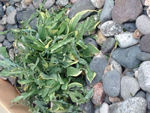
TLC in Order After Hail Storm

Sunday evening, my street looked like a combination of a river and a ski run. We experienced damage to our homes, cars and landscape.
But let's start at the beginning. I was enjoying a Sunday afternoon nap after a hard day of detail work in the yard when I heard the first tap of hail. My phone starting dinging like something major was going to happen.
I realized my car was not in the garage so I ran outside. I pulled the car in and as the door went down and I exited through the walk through door, a golf ball-sized hail hit me in the head. This was the first of many thousands that would plague our area. So, with a garbage can lid on my head, I ran to the house to watch the storm.
Standing close to a sliding glass door on the west side of the house, I realized I should move when the hail began to break through the screens and hit the glass. I was sure one of them would break or at least crack. So, I joined the rest of our community watching from a distance as our landscapes were pummeled. The early spring flowers and peonies that were growing like crazy are now mere shadows of what they were. So, what to do?
There are a couple schools of thought, but I've tried to take the best points from each to assemble my plan. There are two main issues. First, the plants and trees are traumatized from the wind and hail. Second, the intense amount of water depletes the soil of nutrients.
With that in mind, the rule of thumb for annuals and perennials is that if any part of the plant is broken or bent, the plant should be trimmed at the point of the break or further. They are not able to repair themselves and everything after the break will eventually fade and die if it hasn't already. Removing the damaged foliage allows the plants to put energy into sending new growth out rather then trying to feed dying parts.
TRIM
Soft foliage like Hosta and Coleus that just have holes in the leaves can be left alone. But, if the foliage looks like it's been through a paper shredder, it needs to be removed. Trees should be pruned immediately, removing all broken limbs so that they don't come crashing down during the next storm.
FEED
It is very important that all annuals, perennials and trees be fed with a good fertilizer several times over the next three weeks. With some warm sunny weather, they will rebound quickly. And, watering is a key component.
HAND WATER
Remember that while it did rain a lot, most of it just rushed by and did no good for the plants. Carefully check the moisture levels of the soil and continue to water sparingly, but don't stop watering. This is a time to hand-water with a hose, reaching specific areas that need it. Do not rely completely on automatic sprinklers that could over-water if they are left at their regular settings, or under-water if they are turned off.
I turned my auto sprinklers back 50% and plan to leave them that way for a couple of weeks. All other watering will be by hand in consistent daily quick doses with water soluble fertilizer until the weather stabilizes.
Life in the garden is uncertain; storms and setbacks will come but the memories of rebuilding will last a lifetime.



